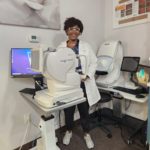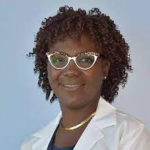
Dr. Dune with her OCT, which she says has elevated care and made it possible to keep more patients in the practice rather than referring out.
By Barbara Dune, OD
Oct. 19, 2022
When you start a practice cold, you have to consider both what you most need to get started, and what will help you build a strong, profitable practice into the future. Here are the most important investments I made for my cold-start practice, which I launched around two years ago.
Wide-Field Imaging
I knew I wanted my practice to be capable of delivering full-scope medical eyecare. That meant that, from the beginning, I would need advanced technology. The first piece of major equipment I purchased was an Optos. I started with a used version of this technology and then upgraded quickly to a new Optos Daytona.
Editor’s Note: There are other wide-field imaging technologies to choose from. Other options include the EIDON Ultra-Widefield Module from iCare and the THUNDER Imager from Leica Microsystems, among others.
I am able to better manage my many diabetic patients with this technology, as it gives me a sharp view of the peripheral retina. It provides a much wider view of my patient’s eyes than I am able to get with the other advanced technology we own, or with my own eye during dilation. It also enables me to get a sense of which of my diabetic patients could benefit from additional advanced imaging.
I feel that the information I gather from wide-field imaging is so valuable that I have built it into our out-of-pocket exam fee. I offer it to my patients who are using their insurance to cover their comprehensive eye exam, letting them know that an out-of-pocket fee will be required if there is no pathology found. My patient base is middle-to-lower income, so I have to be careful in how I present out-of-pocket costs.
ROI: The Optos Daytona cost around $74,000, which I financed with payments of $1,400 for 72 months. I currently see 55-60 patients per month that I can bill out for Optos imaging. At this point, we are breaking even on this investment, however, given the volume of patients I am seeing, it will become a profit center for my practice within about a year.
OCT
In April 2022, I decided it was time to add an OCT to my young practice. Our patient demographics are older and African American or Hispanic, with many more AMD and glaucoma patients than I initially expected. Traditionally AMD was thought of as a disease impacting older Caucasians, but I have been surprised by the high number of Black and Hispanic patients I am diagnosing with AMD. I had an Optos, but still wasn’t getting the images of the macula I needed to feel secure about managing these patients myself. I also knew that imaging with an OCT was necessary for managing my glaucoma patients.
After researching the OCT market, I decided on the Maestro OCT from Topcon Healthcare.
Editor’s Note: There are other OCT systems to choose from, including those from Visionix, ZEISS and Heidelberg Engineering, among other manufacturers.
ROI: The technology cost $43,000, which I financed through a bank loan that requires monthly payments of around $1,000 for 36 months. The enhanced scanning of the optic nerve and macula provided by this technology is enabling me to keep and manage as many as 15 patients per month in my practice who I would have referred to another doctor for care in the past.
Automated Recall
Getting patients to show up for yearly appointments, and return as planned for treatments and follow-up care, is hard. After a few months in practice, I realized we needed to try a new way of doing it. The technology we invested in, Weave, automates messaging by text and e-mail, giving patients the ability to text back if they need to cancel, rather than having to call us. Within a few weeks, our no-show rate went from almost 75 percent to 30 percent.
Other Articles to Explore
Editor’s Note: There are many other recall systems to choose from, including Demandforce, Solutionreach and Simplifeye, among other recall/patient communication technologies.
Patients frequently told us that they had called us and yet we missed their call. The software shows us the calls we miss, so for those patients who still want to communicate with us by phone, we are much less likely to have their voicemail, or missed call alert, slip past us in the rush of our busy clinic schedule.
In addition, the software integrates with our EHR, so that we are able to see if the patient we are talking to about an upcoming appointment has family members in our database who also need to see us. We often get new appointments this way.
ROI: It cost us $7,400 for the first year of use of the technology, and will cost around $6,000 annually going forward. Some 45 percent of patients, who otherwise would have cancelled without telling us, are now either making it to their appointment, or giving us advance warning they need to cancel, giving us the opportunity to fill those appointment slots. The revenue from these appointments that we are able capture, or fill with another patient, easily will add up to at least twice as much as what we are spending on this technology.
 Barbara Dune, OD, of Serenity I Care in Hartford, Conn. To contact her: dunevision2020@gmail.com
Barbara Dune, OD, of Serenity I Care in Hartford, Conn. To contact her: dunevision2020@gmail.com

























